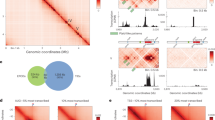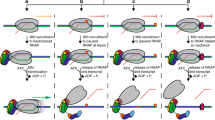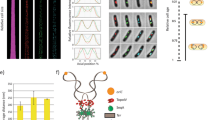Abstract
FtsK is a bacterial protein that translocates DNA in order to transport chromosomes within the cell. During translocation, DNA's double-helical structure might cause a relative rotation between FtsK and the DNA. We used a single-molecule technique to quantify this rotation by observing the supercoils induced into the DNA during translocation of an FtsK complex. We find that FtsK induces ∼0.07 supercoils per DNA helical pitch traveled. This rate indicates that FtsK does not track along DNA's groove, but it is consistent with our previous estimate of FtsK's step size. We show that this rate of supercoil induction is markedly near to the ideal value that would minimize in vivo disturbance to the chromosomal supercoil density, suggesting an origin for the unusual rotational behavior of FtsK.
This is a preview of subscription content, access via your institution
Access options
Subscribe to this journal
Receive 12 print issues and online access
$189.00 per year
only $15.75 per issue
Buy this article
- Purchase on Springer Link
- Instant access to full article PDF
Prices may be subject to local taxes which are calculated during checkout




Similar content being viewed by others
References
Liu, L.F. & Wang, J.C. Supercoiling of the DNA template during transcription. Proc. Natl. Acad. Sci. USA 84, 7024–7027 (1987).
Yang, L., Jessee, C.B., Lau, K., Zhang, H. & Liu, L.F. Template supercoiling during ATP-dependent DNA helix tracking—studies with simian virus-40 large tumor antigen. Proc. Natl. Acad. Sci. USA 86, 6121–6125 (1989).
Tsao, Y.P., Wu, H.Y. & Liu, L.F. Transcription-driven supercoiling of DNA—direct biochemical evidence from in vitro studies. Cell 56, 111–118 (1989).
Koo, H.S., Claassen, L., Grossman, L. & Liu, L.F. ATP-dependent partitioning of the DNA template into supercoiled domains by Escherichia coli UvrAB. Proc. Natl. Acad. Sci. USA 88, 1212–1216 (1991).
Janscak, P. & Bickle, T.A. DNA supercoiling during ATP-dependent DNA translocation by the type I restriction enzyme EcoAl. J. Mol. Biol. 295, 1089–1099 (2000).
Harada, Y. et al. Direct observation of DNA rotation during transcription by Escherichia coli RNA polymerase. Nature 409, 113–115 (2001).
Seidel, R. et al. Real-time observation of DNA translocation by the type I restriction modification enzyme EcoR124I. Nat. Struct. Mol. Biol. 11, 838–843 (2004).
Lesterlin, C., Barre, F.-X. & Cornet, F. Genetic recombination and the cell cycle: what we have learned from chromosome dimers. Mol. Microbiol. 54, 1151–1160 (2004).
Aussel, L. et al. FtsK is a DNA motor protein that activates chromosome dimer resolution by switching the catalytic state of the XerC and XerD recombinases. Cell 108, 195–205 (2002).
Lau, I.F. et al. Spatial and temporal organization of replicating Escherichia coli chromosomes. Mol. Microbiol. 49, 731–743 (2003).
Saleh, O.A., Perals, C., Barre, F.-X. & Allemand, J.-F. Fast, DNA-sequence independent translocation by FtsK in a single-molecule experiment. EMBO J. 23, 2430–2439 (2004).
Champoux, J.J. DNA topoisomerases: structure, function, and mechanism. Annu. Rev. Biochem. 70, 369–413 (2001).
Ip, S.C.Y., Bregu, M., Barre, F.-X. & Sherratt, D.J. Decatenation of DNA circles by FtsK-dependent Xer site-specific recombination. EMBO J. 22, 6399–6407 (2003).
Pease, P.J. et al. Sequence-directed DNA translocation by purified FtsK. Science 307, 586–590 (2005).
Strick, T.R., Allemand, J.-F., Bensimon, D., Bensimon, A. & Croquette, V. The elasticity of a single supercoiled DNA molecule. Science 271, 1835–1837 (1996).
Strick, T.R., Allemand, J.-F., Bensimon, D. & Croquette, V. Behavior of supercoiled DNA. Biophys. J. 74, 2016–2028 (1998).
Sase, I., Miyata, H., Ishiwata, S. & Kinosita, K. Axial rotation of sliding actin filaments revealed by single-fluorophore imaging. Proc. Natl. Acad. Sci. USA 94, 5646–5650 (1997).
Ali, M.Y. et al. Myosin V is a left-handed spiral motor on the right-handed actin helix. Nat. Struct. Biol. 9, 464–467 (2002).
Singleton, M.R., Sawaya, M.R., Ellenberger, T. & Wigley, D.B. Crystal structure of T7 gene 4 ring helicase indicates a mechanism for sequential hydrolysis of nucleotides. Cell 101, 589–600 (2000).
Hishida, T., Han, Y.-W., Fujimoto, S., Iwasaki, H. & Shinagawa, H. Direct evidence that a conserved arginine in RuvB AAA+ ATPase acts as an allosteric effector for the ATPase activity of the adjacent subunit in a hexamer. Proc. Natl. Acad. Sci. USA 101, 9573–9577 (2004).
Wang, J.C. DNA supercoiling and its effects on the structure of DNA. J. Cell Sci., 21–29 (1984).
Zechiedrich, E.L. et al. Roles of topoisomerases in maintaining steady-state DNA supercoiling in Escherichia coli. J. Biol. Chem. 275, 8103–8113 (2000).
Bath, J., Wu, L.J., Errington, J. & Wang, J.C. Role of Bacillus subtilis SpoIIIE in DNA transport across the mother cell-prespore division septum. Science 290, 995–997 (2000).
Perals, K., Cornet, F., Merlet, Y., Delon, I. & Louarn, J.M. Functional polarization of the Escherichia coli chromosome terminus: the dif site acts in chromosome dimer resolution only when located between long stretches of opposite polarity. Mol. Microbiol. 36, 33–43 (2000).
Bouchiat, C. et al. Estimating the persistence length of a worm-like chain molecule from force-extension measurements. Biophys. J. 76, 409–413 (1999).
Efron, B. & Tibshirani, R. Statistical data analysis in the computer age. Science 253, 390–395 (1991).
Acknowledgements
We thank D. Bensimon and V. Croquette for helpful discussions, and K. Neuman for critical reading of the manuscript. This work was supported by the DRAB 2004 program. Research in Paris was also supported by grants from the ACI Jeune Chercheur program and from the European Union MolSwitch program. Research in Toulouse was also supported by grants from the Centre National de la Recherche Scientifique ATIP program and from the French Research Ministry Fundamental Microbiology ACI program.
Author information
Authors and Affiliations
Corresponding author
Ethics declarations
Competing interests
The authors declare no competing financial interests.
Supplementary information
Supplementary Fig. 1
Slipping by FtsK50C near the positive buckling threshold. (PDF 41 kb)
Supplementary Fig. 2
DNA topology changes induced by FtsK50C translocation. (PDF 138 kb)
Rights and permissions
About this article
Cite this article
Saleh, O., Bigot, S., Barre, FX. et al. Analysis of DNA supercoil induction by FtsK indicates translocation without groove-tracking. Nat Struct Mol Biol 12, 436–440 (2005). https://doi.org/10.1038/nsmb926
Received:
Accepted:
Published:
Issue Date:
DOI: https://doi.org/10.1038/nsmb926
This article is cited by
-
Finding of widespread viral and bacterial revolution dsDNA translocation motors distinct from rotation motors by channel chirality and size
Cell & Bioscience (2014)
-
Separating speed and ability to displace roadblocks during DNA translocation by FtsK
The EMBO Journal (2010)
-
Fully efficient chromosome dimer resolution in Escherichia coli cells lacking the integral membrane domain of FtsK
The EMBO Journal (2010)
-
Giant proteins that move DNA: bullies of the genomic playground
Nature Reviews Molecular Cell Biology (2006)
-
Identification of the FtsK sequence-recognition domain
Nature Structural & Molecular Biology (2006)



